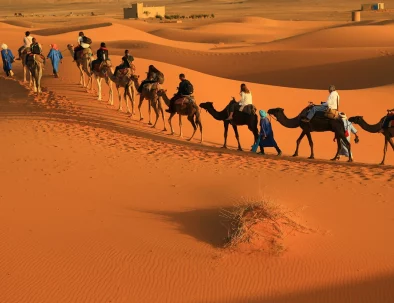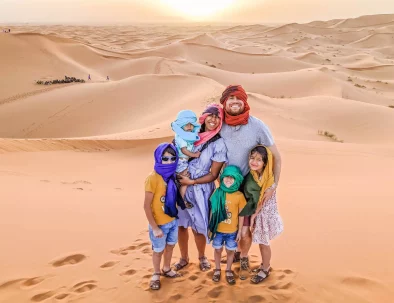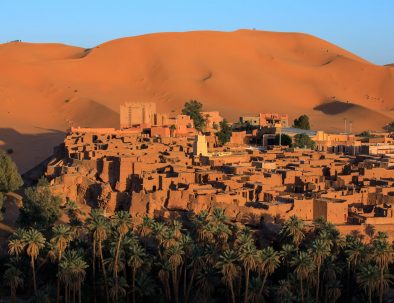Day 1: Tangier and Chefchaouen, the "Blue City"
Tangier is the place where Europe and Africa meet. Near the south of Spain, you can go to the medina (the old part of town), a café in the cool Zoco Chico square, or a paseo (a walk along the promenade). Or, go straight to Chefchaouen, a blue-painted city in the Rif Mountains. Enjoy the beautiful route and stop to hike to the Cascades d’Akchou (Waterfalls of Akchour). Chefchaoen has a lot of narrow, winding streets and pretty buildings. Find a restaurant or café in Plaza Outa el Hammam and eat there while you watch people.
Even though non-Muslims can’t go inside, the Grand Mosque is still worth seeing. You can visit the nearby kasbah, an old fort, and look around the garden, museum, and some old prison cells. Follow a path outside the city walls to the Hotel Atlas, and then go up to the roof to see the Blue City from a different angle. Follow the street east to go over the Ras el Ma Spring and climb the path (20–30 minutes) until you reach the white Spanish Mosque that has been left empty. As the sun sets behind the mountains, you can get one last look at Chefchaouen.
Day 2: The Roman ruins of Volubilis and the imperial cities of Meknes and Fes
Get up early to take pictures of the empty streets before you leave for Fes. Stop along the way at the UNESCO-protected ruins of Volubilis, which were the Romans’ most distant outpost in Africa. You can walk around the complex and look at merchant homes with working heating systems, temples, and many mosaics still in place. Continue to Meknes, a smaller, less busy version of Fes, which can give you an idea of what an imperial city was like in the past. The Ville Impériale and the medina are the two most exciting places to visit. Make sure to see the Royal Stables, the Royal Stables, and the Bab al-Mansour gate.
Keep going to Fes. Fes is a town worth getting lost in because its old medina is vast and confusing. Before you go into the medina, take the time to visit the Merenid Tombs, which are just north of the city. You can see the whole of old Fes and the surrounding area. Come down the hill and spend the night in your riad, a traditional Moroccan house with a garden inside.
Day 3: In Fes, we visit the Imperial City and the Medina, a medieval city.
Today you have a free day to discover the blue city of Chefchaouen with its whitewashed houses.
Meknes, Marrakech, and Rabat are the other imperial cities in Morocco, but Fes is the oldest and might be the most interesting to visit. The town is a UNESCO-protected site that has mostly stayed the same from its medieval style because of colonial changes. Fes has two old medina quarters, Fes el Bali and Fes el Jdid. Fes el Bali is where you will spend most of your time, and Fez El Jdid is a slightly newer part of the city. The French built Ville Nouvelle in the early 20th century. Start in Fes el Bali to meet your guide, who will help you find your way through the narrow, old streets of the medinas that look like a maze (789 CE).
As you walk through the different souks (markets) that sell spices, leather goods, and pewter, look at the architecture influenced by Spain and Tunisia. Visit the well-known Chouara Tannery and climb up to the roof of a nearby shop to get a better view of what’s happening. The area is known for its smelly tanneries. Visit the 14th-century Al Attarine Madrasa and look at the zellij tilework. Then go to Al-Qarawiyyin University, one of the oldest universities in the world that is still in use (859 CE). In Fes el Jdid, go to the Mellah, the old Jewish quarter, for another view of the whole city.
Day 4: Erfoud, Merzouga, and the Sahara in the Middle Atlas
After breakfast in your riad, we will start our tour of Fez via the archaeological site of Volubilis where you can explore Morocco’s famous Roman ruins (UNESCO World Heritage Site in 1997). Then we head to Meknes, the Ismaili capital of Morocco. In Meknes you will visit the
Continue your trip south, going over the Zad Col (7,146 feet or 2,178 m) and through the Middle Atlas cedar forests. As you drive to Midelt (the “apple city”) for lunch, you will see families of Barbary macaque monkeys in the trees and on the side of the road. Take in the sights, like the apple orchards and the Moulouya River. Next, go over the Tizi n’Talremt pass and into the Ziz Valley, which is full of oasis towns and groups of palm trees. Look at the many fortified houses called ksars that merchants built to protect their goods (gold, salt, and spices).
As you get close to Erfoud, you will start to see the first Sahara dunes. The dunes are constantly moving because the winds change. If you’re lucky, you might meet a Berber nomad family and drink tea with them. Visit Erfoud to see how the fossil-filled rocks from its mines are turned into useful and decorative items. Move on to Erg Chebbi, which has many dunes that look like a sea. Some dunes are more than 656.2 feet (200 m) high and cover 13.5 square miles (35 square km). Their colour changes as the sun move across the sky.
Outside Merzouga, slow down and prepare for a camel ride through the dunes. You’ll get to camp right before the sun goes down. Climb the closest dune to watch the colourful show as the sun goes down behind the huge dunes. When you return to camp, you can eat dinner outside and spend the night around the campfire listening to traditional Berber music played by the locals. Spend the night in a tent like those used by Bedouins.
Day 5: Trips to Merzouga, the Rissani Market, and the Todra Gorge
Wake up early to watch the sun rise over the desert, then try your hand at sandboarding. You can also go on an Erg Chebbi (dune) tour or an ATV tour. Visit the traditional Saharan village of Khemliya, which is close by. You can see and hear traditional drumming and dance there before taking a short walk around the village. Leave the dunes behind and stop in Rissani, a market town with an impressive gate. Finding the “donkey parking lot” is worth your time to please your senses. The town is known for its livestock auction.
Keep going to Tinerhir. This desert town has great views of the towns next to it that hug the long river oasis (30 miles or 49 km of palm trees). Stop at the Todra Gorge, which is today’s last stop. The Todra River cut a gorge through red limestone 984 feet (300 m) high. You can take a leisurely walk through and around the gorge and cool off in the shallow river.
Day 6: Dades Valley, Ouarzazate & Ait Benhaddou Kasbah
Follow the Valley of a Thousand Kasbahs to get to At Benhaddou, the most famous kasbah in Morocco. Go through Boumalne Dades and the Dades Valley. Stop in Kelaat M’Gouna to look at the rose bushes that line the fields. Visit a rose comparative to see how rose petals are turned into oil and water. Stop in Ouarzazate on your way west to learn about how movies like Lawrence of Arabia, Gladiator, and Black Hawk Down were filmed in the area. Join a tour of a movie studio and go to the Musée du Cinema to learn more about how movies are made and how the area has changed over time.
Go to At Benhaddou, which is close by. The old ksar is a UNESCO World Heritage site. It was built in the 11th century and was an important part of the trans-Saharan trade route. Settling into your room in the old town will give you time to walk around the nearly empty streets and alleys in the late afternoon. Climb the old Granary, a great place to see the kasbah and the area around it. Fans of the popular HBO show Game of Thrones might want to go down to the river to see the gates in the show. Enjoy a quiet dinner with a view of the valley long after the day’s crowds have gone.The route continues towards the dunes of Erg Chebbi passing through Aoufous and Erfoud, the capital of fossils, where you may wish to visit a local fossil craft workshop. After that, we will continue to the stunning dunes of Erg Chebbi. Arrive at the hotel and get ready for a 1.5-hour camel ride to enjoy the sunset. Night and dinner at the campsite in a nomadic tent.
Day 7: Tizi n'Tichka Pass through the High Atlas Mountains to Marrakech
Leave At Benhaddou behind to start the climb over the High Atlas mountains. Find the mountain range’s highest peak, Mount Toubkal, which is 13,671 feet high (4,167 m). When you get close to the top, stretch your legs and look around to see a great view of the mountains. Stop by the Argan Oil Cooperative in Taddert to learn how olives are processed for different uses and to try some of them. The weather and landscape will change significantly as you go down the High Atlas. Soon, you’ll be a part of Marrakech’s noise and chaos.
After a long day of driving, check into your hotel and do whatever you want for the rest of the afternoon. In the early evening, musicians, performers, snake charmers, games, and food stalls bring Jemaa el-Fna, the main and busiest African square, to life. If you want to watch the show from afar, you can go to one of the many cafés around the square and have a meal and a cup of mint tea.
Day 8: Visit the Red City, Marrakech
Marrakech has been a busy city since the time of the Berber Empire when the city walls and buildings were made of red sandstone, which gave it the name “Red City” (1062 ACE). Meet your guide for a half-day tour. First, look through the spice stalls at Souk el Attarin, blacksmith stalls at Souk Haddadine, and jewellery stalls at Souk Smata (slippers). Visit the dyers’ market (Souk des Teinturiers) and the Koutoubia Mosque. Along the way, keep an eye out for the open spaces that lead off some alleys. In the Middle Ages, these fondouks were inns where travellers and merchants could stay with their animals.
The hard-to-miss Mosque has the tallest tower in Marrakech. Its minaret is 253 feet (77 m) high. Before going to Ben Youssef Madrasa, you can take a break in the nearby gardens. This madrasa was built in the 1600s and used to house students from the nearby Mosque. Look at the carved cedar, stucco plaster, and zellij tiles made in Morocco. You can see more traditional art and woodwork examples at the Marrakech Museum or the Museum of Moroccan Arts. The Bahia Palace, El Saadian Tombs, Bahia Palace, and the Jewish Mellah and cemetery are worth seeing in the Kasbah area, which is south of Jemaa el-Fna.
Day 9: Essaouira
Say goodbye to the Red City and take a route over extensive, rolling plains to Morocco’s west coast. Pass through a forest of argan trees, only found in this part of the world. You might even see goats up in the tree branches eating argan fruit. Visit an Argan oil cooperative to learn how argan oil is taken from the tree and what it is used for in the food and beauty industries.
Arrive in the laid-back port city of Essaouira, which is a nice change from the busy city of Marrakech, and spend the rest of the day however you like. Walk along the coast on the Skala de la Kasbah ramparts, which were built in the 1800s. Old brass cannons, which European engineers built, line the walls and let people look out over the Atlantic. Visit the medina, which is protected by UNESCO, before going to the windswept beach. Fans of Jimi Hendrix may want to take a short ride to Diabat at the end of Essaouira’s coast, where he is said to have spent some time. Walk back to Essaouira and eat seafood that was just caught.
Day 10: Go back to Marrakech and leave.
Before you head back to Marrakech, you can walk along the beach or buy any last-minute souvenirs. If you have time, you should go to the Majorelle Gardens. The gardens with subtropical plants, bamboo, lilies, and palms are a great place to get away from the heat and noise of the afternoon before your flight back home. They are close to the medina.



